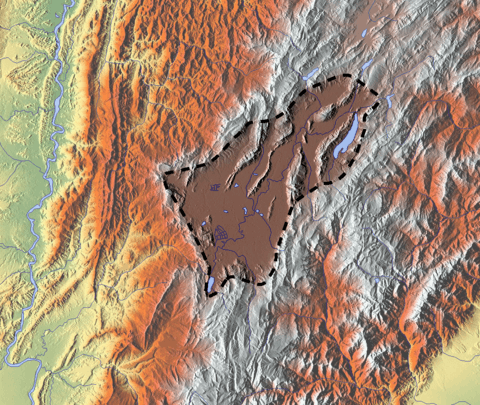Cacho Formation
The Cacho Formation (Spanish: Formación Cacho, E1C, Tpc, Tec) is a geological formation of the Altiplano Cundiboyacense, Eastern Ranges of the Colombian Andes. The predominantly sandstone formation with thin intercalated beds of shales dates to the Paleogene period; Middle to Late Paleocene epochs, and has a maximum thickness of 400 metres (1,300 ft).
| Cacho Formation Stratigraphic range: Mid-Late Paleocene ~60–55 Ma | |
|---|---|
| Type | Geological formation |
| Underlies | Bogotá Formation |
| Overlies | Guaduas Formation |
| Thickness | 50–400 m (160–1,310 ft) |
| Lithology | |
| Primary | Sandstone |
| Other | Shale |
| Location | |
| Coordinates | 4°35′11.4″N 74°14′25.8″W |
| Region | Bogotá savanna Altiplano Cundiboyacense Eastern Ranges Andes |
| Country | |
| Type section | |
| Named by | Julivert |
| Location | Soacha |
| Year defined | 1963 |
| Coordinates | 4°35′11.4″N 74°14′25.8″W |
| Region | Cundinamarca |
| Country | |
Definition
The formation was first described by Hubach in 1931 and 1957 and named by Campbell in 1962 and Julivert in 1963.[1][2]
Description
Lithologies
The Cacho Formation consists of white, yellow and reddish fine to coarse cross-bedded sandstones in thick banks intercalated with reddish and grey shales.[1][3]
Stratigraphy and depositional environment
The 50 to 400 metres (160 to 1,310 ft) thick Cacho Formation overlies the Guaduas Formation and is overlain by the Bogotá Formation.[3] The age has been estimated to be Late Paleocene, based on paleoflora studied by Thomas van der Hammen in 1957. The formation is laterally equivalent to the Lower Socha and Barco Formations.[4]
Outcrops

The Cacho Formation is apart from its type locality in Soacha, found in the Eastern Hills of Bogotá, and many other locations in the Eastern Ranges up until the south of Boyacá.[2] The synclinals of the Río Frío, Checua-Lenguazaque, Sesquilé, Sisga, Subachoque, Teusacá, Siecha, and the anticlinal of Guatavita are composed of the Cacho Formation.[1]
See also
References
- Montoya & Reyes, 2005, p.55
- Acosta & Ulloa, 2002, p.58
- Guerrero Uscátegui, 1992, p.5
- Montoya & Reyes, 2005, p.57
Bibliography
- Acosta Garay, Jorge E., and Carlos E. Ulloa Melo. 2002. Mapa Geológico del Departamento de Cundinamarca - 1:250,000 - Memoria explicativa, 1-108. INGEOMINAS. Accessed 2017-03-29.
- Guerrero Uscátegui, Alberto Lobo. 1992. Geología e Hidrogeología de Santafé de Bogotá y su Sabana, 1–20. Sociedad Colombiana de Ingenieros.
- Montoya Arenas, Diana María, and Germán Alfonso Reyes Torres. 2005. Geología de la Sabana de Bogotá, 1–104. INGEOMINAS.
Maps
- Fuquen M., Jaime A, and José F. Osorno M. 2009. Plancha 190 - Chiquinquirá - 1:100,000, 1. INGEOMINAS. Accessed 2017-06-06.
- Montoya, Diana María, and Germán Reyes. 2009. Plancha 209 - Zipaquirá - 1:100,000, 1. INGEOMINAS. Accessed 2017-06-06.
- Terraza, Roberto; Giovanni Moreno; José A. Buitrago; Adrián Pérez, and Diana María Montoya. 2010. Plancha 210 - Guateque - 1:100,000, 1. INGEOMINAS. Accessed 2017-06-06.
- Buitrago, José Alberto; Roberto Terraza M., and Fernando Etayo. 1998. Plancha 228 - Santafé de Bogotá Noreste - 1:100,000, 1. INGEOMINAS. Accessed 2017-06-06.
External links
- Gómez, J.; N.E. Montes; Á. Nivia, and H. Diederix. 2015. Plancha 5-09 del Atlas Geológico de Colombia 2015 – escala 1:500,000, 1. Servicio Geológico Colombiano. Accessed 2017-03-16.